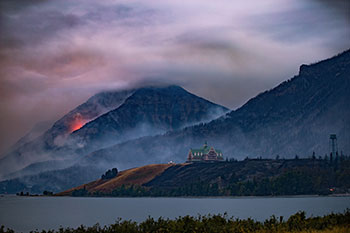
Fire
Waterton Lakes National Park
Natural processes greatly influence Waterton Lakes National Park and the greater Crown of the Continent ecosystem.
They shape the land and, although they appear destructive, they are important for renewing and producing variety in the park's living landscapes.
In Waterton Lakes National Park, the three most critical natural processes are fire, flood and avalanches.
Fire is as important as water, sun and wind. Fires don't just destroy, they create. When fire moves through a forest or over grasslands, many important things happen.
Dead plant material which has accumulated is burned, and nutrients tied up in that material are recycled for new growth. This regrowth provides new sources of food and shelter to wildlife. Fire also creates a mosaic of plant communities that provides a greater variety of habitats for animals.
Fires also eat up dangerous buildups of fuel in forests and grasslands created by dead wood, branches and other debris. This reduces the risk of more intense, difficult to control fires which may threaten people and property.
In the past, fires were totally suppressed, and their benefits lost. One way of reintroducing fire to the landscape is by prescribed burning. Small experimental prescribed fires have been lit, under very strict conditions, on various grassland areas in the park since 1989.
They lessen the intensity of wildfires by reducing the amount of dead grass and trees in a given area. They also create a mosaic of habitat types, opening up areas and creating habitat preferred by edge dwelling animals such as Lewis Woodpeckers and Northern Toads.
Since 2002, Waterton Lakes National Park has burned approximately 5,025 hectares using prescribed fire.
The Sofa Mountain Wildfire (1998) and Kenow Wildfire (2017) were major wildfires in the park. They have provided an invaluable opportunity to study the ongoing affects of a large-scale natural fire.
Kenow Wildfire

The Kenow Wildfire established itself in Waterton Lakes National Park on September 11, 2017.
It moved at a high rate of speed down the Cameron Valley along the Akamina Parkway. Later in the evening, flames were visible from the Townsite and on the north side of Crandell Mountain.
The wildfire spread through the grasslands along the park’s Entrance Road. Overnight, it moved north and east out of the park and into adjacent lands.
In the end, the wildfire burned approximately 35,000 hectares, including 19,303 hectares in Waterton Lakes National Park, and had a significant impact on built infrastructure in the park.
Watch a safety-focused webinar hosted by the Waterton-Glacier International Peace Park Association. Wildfire in the Backcountry: What To Do When it Comes to You!
Related links
- Date modified :